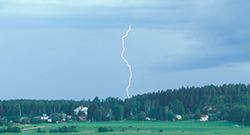Sharp fluctuation in temperatures in May
 Kuva: Asko Hämäläinen
Kuva: Asko HämäläinenAccording to the Finnish Meteorological Institute, average temperatures of May varied between just over 10°C in the south of the country to less than +2°C in Enontekiö, the north-west arm of Finnish Lapland. The deviation of the average temperature from the long-term average was not very great in any part of the country. In most of Finland it was slightly warmer than usual, but the deviation amounted to less than one degree. In Central and Northern Finnish Lapland, it was colder than usual. The greatest deviation, just over one degree, was in Enontekiö.
May began with unusually cold temperatures
In spite of the fairly small deviations from the average temperature, the month showed fluctuations in temperature. The month began with colder temperatures than usual, and the unusually cold temperatures continued for nearly three weeks. This phase was unusually cold in places, a situation that happens on average only once every ten years. The month's lowest temperature, -16.3°C, was recorded in Kittilä on the fifth of May.
From about the 20th of May there was a complete change in the type of weather when very warm air flowed into Finland from the southeast. Temperatures rose in most of the country to above 25°C, and in some places to more than 30°C. The highest temperature, 30.8°C was recorded in Heinola on the 19th of May. The figure is just 0.2°C less than the record May temperature in Finland, which was set in 1995.
At the end of the month, cold air flowed into the country from the northeast, at which time temperatures dropped exceptionally sharply. In North Karelia, the decline was by more than 20°C in a 24-hour period.
There were a total of eight days in which temperatures exceeded 25°C somewhere in Finland, while the average for May is three days. The thermal summer began in mid-May in southern and central parts of Finland.
Three times more lighting strikes than usual in May
In May the lightning location sensors of the Finnish Meteorological Institute observed a total of 25,000 cloud-to-ground lightning strikes in Finland, which is three times more than the long-term average for May (8,500). However, this is not a record. For instance, in 1963, 1984, and 1995 the number of lightning strikes exceeded 30,000. A majority of the lighting strikes were on May 19th (13,000) and on May 25th (9,000). Thunder occurred on these days in nearly all of the country, with the exception of Lapland. Lightning was most intense in western, central, and southeastern parts of Finland.
The amount of rain for the month increased in eastern areas, generally exceeding 120 millimetres, but was less than 40 millimetres along the west coast, and in southern and western parts of Finnish Lapland. Rainfall was twice the long-term average in eastern parts of Finland, and in some places it was three times as high. On the west coast and in parts of Lapland there was less rain than normal. The greatest amount of precipitation at weather observation stations was at Lepola in Lappeenranta, where 173.5 millimetres came down. The least amount of rain, 14 millimetres, was measured at Kilpisjärvi in Enontekiö. A new record for precipitation was set in the east of the country at several observation stations. Rain was heaviest in the eastern part of the country on May 13th, and it was on this day that the month's largest amount of rain in a single day, 63.4 mm. was recorded at Mikkeli Airport.
Spring was warmer than usual in all parts of Finland
The average temperature for the spring months, from March through May, was higher than usual in all parts of Finland. The deviation from the average was more than two degrees in central areas, and less than a degree in the northern part of Finnish Lapland. The average temperatures in southern parts rose to above +5°C, but in the north of Finnish Lapland, it remained below freezing. March and April were warmer than usual, March was exceptionally mild, but the average temperature for May was close to normal.
The total precipitation in the spring months was greater than usual in eastern areas and Enontekiö - up to one and a half times the long-term average. On the other hand, in western parts of Finland and in the north, with the exception of northernmost Finnish Lapland, there was less precipitation than normal. In eastern parts, spring rains came mainly in May, while March and April were drier than usual.
Further information:
May weather statistics: http://ilmatieteenlaitos.fi/kuukausitilastotSpring weather statistics: http://ilmatieteenlaitos.fi/kevattilastotThermal growing season: http://ilmatieteenlaitos.fi/kasvukausi-2014